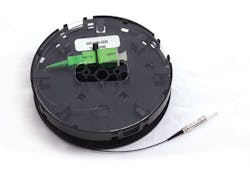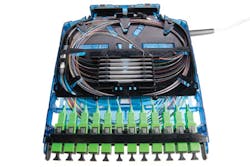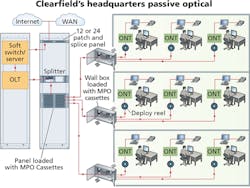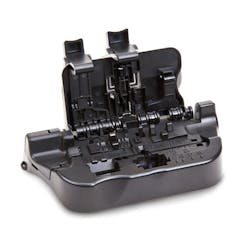The singlemode fiber systems can be preterminated or field-terminated, and manufacturers have taken measures to ease the process for installers.
By Patrick McLaughlin
The value proposition for deploying a passive optical local area network (POLAN) has been made to enterprise organizations for several years. Groups like the Association for Passive Optical LAN (APOLAN; www.apolanglobal.org) have carried the message of money, energy and space savings as reasons it would be worthwhile for enterprises to deploy passive optical LANs. When the APOLAN announced its formation in 2013 the group said, “Passive optical LAN serves as the optimized means to deliver voice, video, data, wireless access, security and high-performance building automation for the federal government and commercial enterprise … The deployments of passive optical LAN to date have demonstrated significant cost and performance advantages compared to traditional Ethernet designs, and the optical foundation futureproofs the network for any new bandwidth demand.”
A significant part of the passive optical LAN’s value proposition comes from the active components used in the network, as well as the architecture of that active gear along with the network’s passive components. In one part of its Reference Guide to Fiber Optics, the Fiber Optic Association (FOA; www.thefoa.org) explains, “Passive optical LANs use standard FTTH architecture and protocols, which are quite different from typical LANs … Passive optical LANs use optical splitters to divide the optical signal to allow up to 32 devices [optical network terminals; ONTs] to be connected to one port on the optical line terminal [OLT] that is the center of the LAN. Downstream, the splitter splits the signal to all the devices and upstream it combines them into one fiber, allowing bidirectional signals on one singlemode fiber. Each ONT is usually a four-port Gigabit Ethernet switch in a LAN, but it can also be a switch for multiple phone lines or even a FTTH triple-play (phone/Internet/TV) converter.”
The FOA has developed an Optical LAN (OLAN) specialist certification-the CFOS/L-for which training is available. The coursework for the CFOS/L certification includes study of passive optical LAN. The FOA’s Reference Guide includes a section labeled “Designing and Installing OLANs,” in which it says, “Most buildings designed within the last 20 years have been designed around structured cabling with large areas set aside for pathways and spaces, most of which are not necessary for OLANs. Some OLAN users have actually recovered spaces allocated for telecom rooms. Cable trays emptied when obsolete UTP cables are removed for recycling can be left since removing them is costly. Older buildings that were designed before structured cabling standards that have always been difficult to install cabling systems are much easier.” Later, the FOA Reference Guide states, “OLANs are using only singlemode cables, which are easy to install but require special termination procedures (generally prepolished/splice connections) or using prefab cable assemblies. Many of the components are similar to those developed to ease installation of FTTH. Manufacturers have also developed special hardware to simplify the prefab cable plant installation.”
Prescribing preterm
What the FOA calls “prefab” cabling many refer to as “preterminated” or “preterm.” The FOA’s reference to special hardware that simplifies prefab/preterminated cabling installation refers to equipment like Clearfield’s (www.clearfieldconnection.com) SmartRoute Deploy Reel, which houses the company’s StrongFiber cabling. The reel is an example of a product developed to ease fiber-to-the-home (FTTH) installation and now also is being used in the passive optical LANs that are based on the same architecture. In describing Deploy Reel and its use, Clearfield explains, “Due to the variability of MDU architectures, extensive engineering has been required to ensure proper cable lengths for FTTp [fiber-to-the-premises] deployments. With StrongFiber, pre-engineering is minimal because the 4.5-inch SmartRoute Deploy Reel, upon which StrongFiber is shipped, can be mounted at the destination site and the desired length simply pulled from the wheel to the access point. Once the pullable connector has reached its destination, the connector assembly is completed with the supplied connector housings and the connector is mated to the adapter. The remaining slack on the reel is pre-stored, with no further slack management required.”
Clearfield’s application engineering technical manager Brian Schrand explained, “When you bring fiber to the desktop, especially using plug-and-play, storing slack is the biggest challenge. Deploy Reel lets the slack stay at the desk.” In some passive optical LAN applications, Clearfield’s Deploy Reel is incorporated into Zhone Technologies’ (www.zhone.com) ONT; in this setup, the fiber is pulled from the ONT to the desk.
That is exactly the approach Clearfield took at its own headquarters in Minneapolis, MN recently when it deployed a passive optical LAN in a new, 80,000-square-foot space that includes approximately 350 desktops. “When we built our new headquarters we chose to walk the talk,” commented Cheri Beranek, Clearfield’s president and chief executive officer. “We needed a broadband network with screaming speeds that would showcase the benefits of fiber-optic solutions while also supporting the needs of our employees now and far into the future. A Gigabit Passive Optical Network was the answer, and Zhone provided the key access solutions to make it happen.”
Clearfield provided the passives. Schrand noted, “Comcast delivered 24 fibers; we used 4 of them. Our resident field engineer spliced the fibers into our patch and splice cassette, which is the building block of our product line.” The diagram in this article illustrates the architecture of the passive optical LAN in Clearfield’s headquarters, with MPO-based cassettes strongly present.
With this installation taking place in Clearfield’s own facility, the company’s chief information officer, Michael McMillan, weighed in: “As an IT professional who has been running traditional copper Ethernet for 25 years, initially this was outside my comfort zone. Once the project was completed, I found the GPON network to perform exceptionally well.” Commenting on the fact that the deployment took eight weeks from the moment McMillan ordered the equipment to the day employees moved into the office, he added, “The GPON system was fast and easy to design, administer and install. So far it has been absolutely bulletproof.”
Team effort
Experts from Zhone and Clearfield were on-site for the project, which would be the case even if the installation was taking place somewhere other than a Clearfield facility. “One of the reasons we’re successful is we’re very hands-on with customers,” Schrand said. “This is a new technology. We understand its nuances.”
Ryland Marek, manager of business development for premises networks with 3M (www.3m.com), explained that collaboration between the provider of passive components and the provider of active components takes place from the outset of a project. Users must first understand the passive optical LAN technology as a whole, then begin to understand the active and passive components it comprises. “Many of the questions we hear from our customers are not just about our [passive] products; they are about the actives as well,” Marek noted. A duo representing the actives provider and the passives provider typically is able to answer a customer’s questions about the technology as a whole, as well as a deployment project. Marek said a group of four organizations is critical throughout the process: the actives provider, the passives provider, the integrator, and the distributor. The integrator is experienced using the active technologies that will be deployed (often from Zhone Technologies or Tellabs [www.tellabs.com]). “Integrators that understand the customer’s pain points tend to have the most success,” he said.
Easier installs
Like Clearfield, 3M developed products for passive optical LAN deployments with a specific objective of easing the fiber-system installation. Marek recalled, “When we built our portfolio we started from scratch, from an enterprise standpoint.” Although the passive components in a passive optical LAN are essentially the same as those found in fiber-to-the-home networks-cables, splitters, connectivity-Marek explained 3M didn’t simply redirect its fiber-to-the-home product set to enterprise environments. “We said, ‘Let’s start fresh on that set of components. Let’s design them for an enterprise end-user. They’ll want something small and easy to deploy even in a building with space constraints.’”
Knowing there are numerous ways to cable a building, 3M decided to establish product sets based on two design options: One for user organizations that intend to use their existing telecom-room space, and the other for organizations that will skip the telecom rooms. The portfolio aimed at the latter group includes products that enable the deployment of equipment like splitters in workgroup areas and hallways. “When we specified our solution we made it small, basic, and interchangeable,” Marek said. “Our products can swap out in any of the different housings, including a wall enclosure or a ceiling enclosure, for example.”
In addition to offering product sets for organizations using telecom rooms and those not using them, 3M offers preterminated and field-terminated product sets for passive optical LANs. Marek emphasized that in both cases, the products serve to simplify the installation process. About preterminated systems he said, “We have a full set of options for a customer to be able to have boxes show up, take the cabling out, and plug it in.” And concerning field termination, he noted, “3M has been in that space since 1980. We have technologies to simplify the process.”
Among the newest such products is 3M’s disposable Easy Cleaver, which the company says “enables simple installation and lower up-front cost when terminating all 3M flat-cleave field-installable connectors and splices. Unlike other fiber cleavers, which can cost hundreds or even thousands of dollars up front, the 3M Easy Cleaver is included with select packages of field-installable fiber connectors and splices.”
“We’re focused on the unique ways technicians in the field can make the process easier,” Marek said. Easy Cleaver is one of those ways.
The company’s OnePass system, originally designed and implemented in multi-dwelling units as part of service providers’ fiber-to-the-home networks, also has been deployed in enterprise passive optical LANs. As a fiber-to-the-home infrastructure, OnePass has been deployed in buildings like many in New York City, where bringing fiber to the home means not just to the building entrance, but also through the building and in particular through horizontal space. The system does not require above-ceiling access. “Passive optical LANs have brought the OnePass portfolio to enterprise users,” Marek said. “It has married up nicely to several environments, particularly where it is a challenge to get cable into a wall for any reason.”
The information campaign of the last couple years, put on by companies and organizations supporting passive optical LAN deployment, herald the technology’s potential for savings as well as its proven effectiveness in fiber-to-the-home deployments around the globe. A reality is that the passive infrastructure supporting these networks also has its heritage in those fiber-to-the-home networks. However, the optical cabling systems that support passive optical LANs are not simply repackaged or rebranded FTTH cabling systems. Rather, where appropriate, they have been redesigned to meet the specific needs and constraints of many enterprise network environments.
Patrick McLaughlin is our chief editor.




